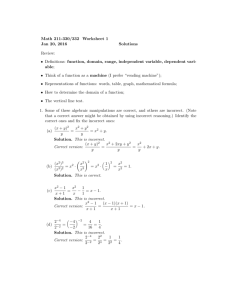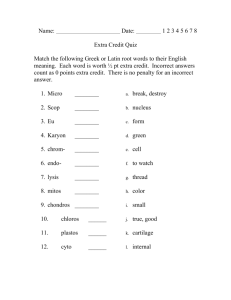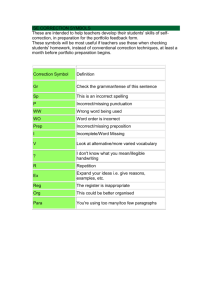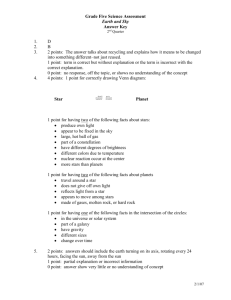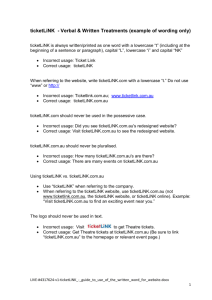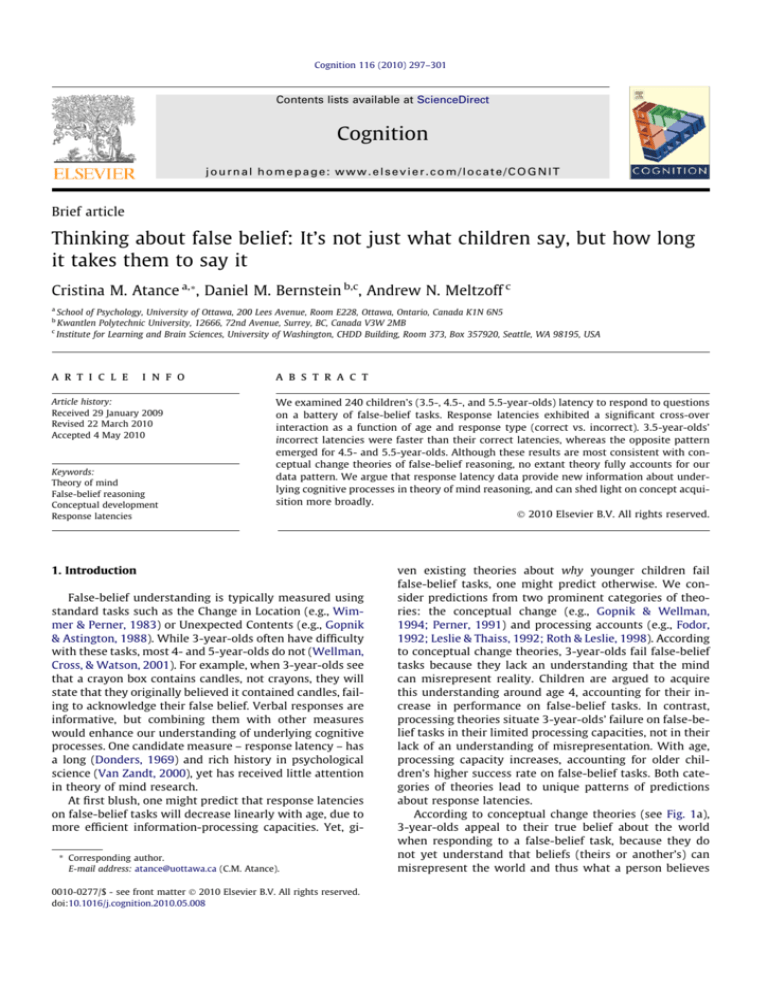
Cognition 116 (2010) 297–301
Contents lists available at ScienceDirect
Cognition
journal homepage: www.elsevier.com/locate/COGNIT
Brief article
Thinking about false belief: It’s not just what children say, but how long
it takes them to say it
Cristina M. Atance a,*, Daniel M. Bernstein b,c, Andrew N. Meltzoff c
a
School of Psychology, University of Ottawa, 200 Lees Avenue, Room E228, Ottawa, Ontario, Canada K1N 6N5
Kwantlen Polytechnic University, 12666, 72nd Avenue, Surrey, BC, Canada V3W 2MB
c
Institute for Learning and Brain Sciences, University of Washington, CHDD Building, Room 373, Box 357920, Seattle, WA 98195, USA
b
a r t i c l e
i n f o
Article history:
Received 29 January 2009
Revised 22 March 2010
Accepted 4 May 2010
Keywords:
Theory of mind
False-belief reasoning
Conceptual development
Response latencies
a b s t r a c t
We examined 240 children’s (3.5-, 4.5-, and 5.5-year-olds) latency to respond to questions
on a battery of false-belief tasks. Response latencies exhibited a significant cross-over
interaction as a function of age and response type (correct vs. incorrect). 3.5-year-olds’
incorrect latencies were faster than their correct latencies, whereas the opposite pattern
emerged for 4.5- and 5.5-year-olds. Although these results are most consistent with conceptual change theories of false-belief reasoning, no extant theory fully accounts for our
data pattern. We argue that response latency data provide new information about underlying cognitive processes in theory of mind reasoning, and can shed light on concept acquisition more broadly.
Ó 2010 Elsevier B.V. All rights reserved.
1. Introduction
False-belief understanding is typically measured using
standard tasks such as the Change in Location (e.g., Wimmer & Perner, 1983) or Unexpected Contents (e.g., Gopnik
& Astington, 1988). While 3-year-olds often have difficulty
with these tasks, most 4- and 5-year-olds do not (Wellman,
Cross, & Watson, 2001). For example, when 3-year-olds see
that a crayon box contains candles, not crayons, they will
state that they originally believed it contained candles, failing to acknowledge their false belief. Verbal responses are
informative, but combining them with other measures
would enhance our understanding of underlying cognitive
processes. One candidate measure – response latency – has
a long (Donders, 1969) and rich history in psychological
science (Van Zandt, 2000), yet has received little attention
in theory of mind research.
At first blush, one might predict that response latencies
on false-belief tasks will decrease linearly with age, due to
more efficient information-processing capacities. Yet, gi* Corresponding author.
E-mail address: atance@uottawa.ca (C.M. Atance).
0010-0277/$ - see front matter Ó 2010 Elsevier B.V. All rights reserved.
doi:10.1016/j.cognition.2010.05.008
ven existing theories about why younger children fail
false-belief tasks, one might predict otherwise. We consider predictions from two prominent categories of theories: the conceptual change (e.g., Gopnik & Wellman,
1994; Perner, 1991) and processing accounts (e.g., Fodor,
1992; Leslie & Thaiss, 1992; Roth & Leslie, 1998). According
to conceptual change theories, 3-year-olds fail false-belief
tasks because they lack an understanding that the mind
can misrepresent reality. Children are argued to acquire
this understanding around age 4, accounting for their increase in performance on false-belief tasks. In contrast,
processing theories situate 3-year-olds’ failure on false-belief tasks in their limited processing capacities, not in their
lack of an understanding of misrepresentation. With age,
processing capacity increases, accounting for older children’s higher success rate on false-belief tasks. Both categories of theories lead to unique patterns of predictions
about response latencies.
According to conceptual change theories (see Fig. 1a),
3-year-olds appeal to their true belief about the world
when responding to a false-belief task, because they do
not yet understand that beliefs (theirs or another’s) can
misrepresent the world and thus what a person believes
298
C.M. Atance et al. / Cognition 116 (2010) 297–301
c
Correct
Incorrect
Slower
b
Faster
Response Latencies
a
3.5
4.5
5.5
3.5
Age
4.5
5.5
Age
3.5
4.5
5.5
Age
Fig. 1. Correct and incorrect response latencies predicted by conceptual change theories (Panel a), Leslie and colleagues’ processing theory (Panel b), and
Kikuno et al.’s (2007) processing theory (Panel c). The ages ‘‘3.5”, ‘‘4.5”, and ‘‘5.5” reflect the mean ages typically used in the literature, and map onto the
mean ages in our study.
about the world can conflict with reality (i.e., be ‘‘false”)
(e.g., Wellman, 1990). Accordingly, at age 3, incorrect
responses should be produced quickly – and, importantly,
more quickly than correct responses. This is because incorrect responses comport with how 3-year-olds understand
the situation – what is in the other’s mind must correspond
to what is in the world. Conversely, at ages 4 and 5, correct
responses should take less time to produce than incorrect
responses. This is because children now understand mental
misrepresentation, and correct responses only require
their responding according to this framework. In contrast,
incorrect responses would arise if children were unsure
and were still actively weighing both the concept they
have recently acquired (i.e., ‘‘false belief”) and the reality
of the situation.
Like conceptual change, most processing accounts
would predict that incorrect response latencies be faster
than correct response latencies at age 3. For example, Leslie, Friedman, and German (2004) argue that an earlydeveloping theory of mind mechanism identifies both
‘‘true” and ‘‘false” belief contents concurrently. To answer
a false-belief question correctly, a ‘‘selection processor”
inhibits the true belief. This extra processing step should
result in longer latencies for correct responses (Carlson &
Moses’, 2001, executive function account would predict
similarly) (see Fig. 1b). This theory appears to make the unique prediction that incorrect response latencies at all ages
should be faster than correct response latencies, because
the former are due to inhibition failures. In contrast, Kikuno, Mitchell, and Ziegler (2007) hold a different processing
account. Their account predicts no differences in latencies
at all ages as a function of correctness (see Fig. 1c), because
the reasoning processes underlying correct and incorrect
responses are argued to be identical, save for the fact that
incorrect responses result from a ‘‘reality” bias. Note, however, that by both processing accounts, response latencies
should become faster with age due to more efficient processing capacities.
Kikuno et al. (2007) tested their account using response
latencies with 3- and 4-year-olds.1 They administered one
1
This study was published after we had collected our data. We have,
however, accommodated our predictions to include Kikuno et al.’s processing account.
standard false-belief task and several modified versions in
Experiment 1, and only modified versions in Experiments
2 and 3. No differences in response latency were detected
as a function of whether children were correct/incorrect on
the tasks, and the authors interpreted this null pattern as
support for their processing account.
Although Kikuno et al.’s (2007) study provides a good
starting point to examine false-belief response latencies,
there are several important limitations. First, children only
received one standard false-belief task in Experiment 1,
yielding one data point for the response latency analyses.
This could have contributed to the null effect. Because children’s response latencies can be highly variable (Eckert &
Eichorn, 1977), multiple data points are preferable. Second,
most of the children in their study were 3-year-olds, or
young 4-year-olds – an age range that does not capture
the progression from systematically failing to passing
false-belief tasks. Therefore, their results do not provide a
full developmental account of children’s false-belief reasoning, nor do they allow us to evaluate the merit of the
different theories and predictions that we outlined – our
main goal here. Accordingly, the advances we made in this
study beyond the previous literature were to assess latencies calculated separately for correct and incorrect responses in 3.5-, 4.5-, and 5.5-year-olds on a battery of
four standard theory-of-mind tasks.
2. Method
2.1. Participants
A total of 240 children participated: 85 3.5-year-olds
(M = 41.75 months, SD = 1.72, Range = 37–47 months; 43
female); 51 4.5-year-olds (M = 54.35 months, SD = 0.60,
Range = 53–56 months; 25 female); and 104 5.5-year-olds
(M = 66.60 months, SD = 1.89, Range = 61–72 months; 47
female). Children completed these tasks as part of three
theory-of-mind studies (Bernstein, Atance, Meltzoff, &
Loftus, 2007; Sommerville, Bernstein, & Meltzoff, submitted
for publication) and so the sample did not include equal
numbers of children in each age group. Children came from
a large city and were from predominantly middle– and
upper–middle-class families.
C.M. Atance et al. / Cognition 116 (2010) 297–301
299
2.2. Materials and procedure
2.3. Scoring
We administered the Unexpected Contents (e.g., Gopnik
& Astington, 1988), Change in Location (e.g., Wimmer &
Perner, 1983), Occluded Pictures (e.g., Chandler & Helm,
1984), and Appearance–Reality (Flavell, Flavell, & Green,
1983) tasks. These were selected because they test children’s understanding that the mind represents reality,
rather than being a direct reflection of it, and thus all share
an important conceptual core (see Wellman et al., 2001).
These tasks were embedded within other tasks not discussed here. For all but the Change in Location task, participants answered two test questions, one about their own
false belief/representation and the other about a naïve,
same-age peer (a doll) named Ellie. This resulted in a total
of seven test questions. Children in the different studies received the tasks and the questions about self and other in
either a fixed or counterbalanced order. There were no significant differences in task performance or response latencies as a function of order of task/question administration
or study; thus we collapsed the data across these two
factors.
In the Unexpected Contents task, children were shown a
crayon box, asked what they thought was inside and then
shown that it contained candles. Children then answered
Self (‘‘When you first saw this box, before we opened it,
what did you think was inside?”), Other (‘‘What does Ellie
think is inside?”), and control (‘‘What is really inside the
box?”) questions.
In the Change in Location task, children saw a character
place a ball in a box and then leave. Another character then
moved the ball to a cupboard. When the original character
returned, children answered experimental (‘‘Now when
Billy comes back inside to play, where will he look for
the ball?”) and control (‘‘Where is the ball really?”)2
questions.
In the Occluded Pictures task, children were shown
what appeared to be animal ears behind a series of three
different windows. Whereas animals were revealed
behind the first two windows, for the third window, what
looked like bunny ears was really a sunflower. Children
answered Self (‘‘When I first showed you this window,
all closed up like this, what did you think was underneath?”), Other (”What does Ellie think is under the
window?”), and control (‘‘What is really under the
window?”) questions.
In the Appearance–Reality task, children were shown
what looked like a rock. After discovering that it was really
a sponge, children answered Self (‘‘When you look at this
with your eyes right now, what does it look like?”), Other
(”What does it look like to Ellie?”), and control (‘‘What is
it really and truly?”) questions.
For all tasks, children received credit for passing the test
questions if they answered the accompanying control
question(s) correctly. If control questions were answered
incorrectly, the corresponding test question was treated
as missing data.
Sessions were video-recorded and response latencies
were timed from the videotapes using computer software
with accuracy to the hundredth of a second. Children’s
latencies to respond to the test questions – either verbally
or by pointing (in the Change in Location task only) – were
timed by a primary coder who scored the videotapes. For a
given question (trial), the coder pressed a computer key to
initiate timing immediately after the experimenter finished the last word of the test question, and released the
key at the onset of the child’s response. The computer recorded the duration of the key press for a given trial and
these data were stored in a file for subsequent analysis.
We excluded latencies if participants answered the control
question(s) incorrectly, the experimenter had to repeat the
test question, or if latencies were greater than 10 s, which
occurred on 7/1300 trials (these values were >3 SD from
the mean response latencies; inclusion of these data points
did not change the overall data pattern). Scoring agreement for latencies was assessed by having a secondary coder time 20% of the data. The two coders had high interrater reliability (single measure intraclass correlation = 0.90; 95% CI = 0.89–0.92). We also calculated the
mean difference between these two coders by computing
the difference between the coders for every trial they
scored (Median disagreement = 0.10 s; M = 0.25 s).
2
Seventy-four participants received a second control question, ‘‘Where
did Billy put the ball?”.
3. Results
Test questions cohered well (Cronbach’s alpha = 0.78),
thus we created a single score by summing individual
scores across the questions (Range = 0–7). We divided this
score by the number of questions for which children
passed the required controls, resulting in a proportion
score. A one-way analysis of variance (ANOVA) showed
that correct responses on the test questions increased
significantly with age, F(2, 237) = 83.31, p < 0.001, partial
g2 = 0.41. Student–Newman–Keuls post hoc comparisons
indicated that 5.5-year-olds (M = 0.78, SD = 0.22) outperformed
4.5-year-olds (M = 0.61, SD = 0.29), who outperformed
3.5-year-olds (M = 0.31, SD = 0.27).
Our main interest was differences between correct and
incorrect response latencies and the extent to which these
conformed to existing theories. Due to the large range in
response latencies and the fact that medians are less affected by outliers than are means, we calculated for each
participant his/her median latency (collapsed across self
and other) for both correct and incorrect responses. We
then entered these median response latencies into a repeated-measures ANOVA with age (3.5, 4.5, 5.5) as a between-subjects factor and response type (correct,
incorrect) as a within-subjects factor3 (note that the
ANOVA statistic produces means based on the medians,
which are hereafter reported). Results showed that latencies
significantly varied by response type, F(1, 159) = 5.34,
3
Participants who answered all seven test questions correctly or
incorrectly were omitted from this analysis. This participant exclusion
did not affect the overall data pattern. Also, the data pattern remains
whether we use median or mean response latency.
300
C.M. Atance et al. / Cognition 116 (2010) 297–301
3
Correct
Response Latencies (in s)
Incorrect
2.5
2
1.5
1
0.5
0
3.5
4.5
5.5
Age
Fig. 2. The effects of age (3.5, 4.5, 5.5) and response type (correct,
incorrect) on children’s response latencies (in seconds) derived from a
repeated-measures ANOVA. Error bars = standard errors.
p = 0.02, partial g2 = 0.03, but not age p = 0.43. The major
effect of interest for theory is that there was a highly significant age response type cross-over interaction for the
latencies, F(2, 159) = 11.33, p < 0.001, partial g2 = 0.12 (see
Fig. 2). Paired-samples t-tests revealed that 3.5-year-olds
responded significantly more quickly when incorrect
(M = 1.59 s) than when correct (M = 2.12), t(57) = 2.61,
p = 0.01. The pattern reversed for 4.5-year-olds (incorrect,
M = 2.00 s, correct, M = 1.22 s), t(37) = 3.34, p < 0.002, and
5.5-year-olds (incorrect, M = 2.00 s, correct, M = 1.38 s),
t(65) = 3.10, p = 0.003.4
We also ran two between-subjects ANOVAs to better
understand the nature of the interaction that we obtained
(note that these analyses yield different means from those
reported in the repeated-measures ANOVA because they
are based on slightly different subjects). Correct response
latencies decreased significantly with age (M = 2.11,
M = 1.31, and M = 1.28 for 3.5-, 4.5-, and 5.5-year-olds,
respectively), F(2, 212) = 14.17, p < 0.01, whereas incorrect
response latencies did not (M = 1.66, M = 1.98, and
M = 1.97 for 3.5-, 4.5-, and 5.5-year-olds, respectively),
F(2, 186) = 1.39, p > 0.25. Follow-up t-tests, using Bonferroni correction for multiple comparisons, revealed two significant differences: 3.5-year olds were significantly slower
than 4.5- and 5.5-year olds when correct (p < 0.001 for
both tests).
4. Discussion
Our data show a striking cross-over effect: 3.5-yearolds were faster to respond incorrectly than correctly; the
opposite pattern emerged for 4.5- and 5.5-year-olds. The
fact that response latencies were shorter for incorrect than
correct responses in 3.5-year-olds is consistent with both
conceptual change and processing accounts (with the
4
Although there were differences in response latencies across some of
the individual test questions, the fundamental pattern (i.e., 3.5-year-olds
answering more quickly when incorrect than correct, and 4.5- and 5.5-yearolds showing the reverse) emerged across tasks. Specifically, for 17/21
possible comparisons, this pattern held.
exception of Kikuno et al.’s, 2007) because both argue that
the cognitive processes that are engaged when a 3-yearold passes a false-belief task are different (and more
time-consuming) from those when the child fails. However, the fact that older children’s correct latencies were
faster than their incorrect latencies is inconsistent with
processing theories. Leslie and colleagues’ processing theory (see Fig. 1b) would predict slower latencies for correct
responses than incorrect responses across the 3–5 year age
range, because correct responses require an extra inhibitory step. Kikuno et al.’s theory (see Fig. 1c) predicts no difference between correct and incorrect latencies across this
age range.
By a conceptual change account, however, older children’s correct latencies should be faster than their incorrect latencies. This is because correct responses reflect
the fluidity with which the older child’s mind reasons
about false belief – perhaps without the reality-based option being considered prior to responding to a false-belief
task (though see Apperly, Back, Samson, & France, 2008;
and Cohen & German, 2010, for evidence for and against
the idea that false belief reasoning in adults entails processing information about both belief and reality). In contrast, the longer latencies for incorrect responses suggest
that some older children may be experiencing conflict between the correct false-belief-based response and the
incorrect true-belief/reality-based option – with the latter
ultimately winning out.
It is also important to consider the pattern of correct/
incorrect latencies separately across development. Correct
latencies decreased significantly between ages 3.5 and 4.5,
with no measurable difference between ages 4.5 and 5.5.
This finding is inconsistent with processing accounts that
posit that children’s processing capacity gradually increases with age. Rather, it is consistent with the conceptual change account that argues that, after approximately
age 4, children become adept at reasoning about the representational mind. Interestingly, this latency finding does
not directly mirror the significant task improvement either
between ages 3.5 and 4.5 and 4.5 and 5.5. One possible
interpretation is that both 4.5- (61% correct) and 5.5year-olds (78% correct) have undergone a conceptual shift,
indexed by their above-chance performance and, despite
accuracy differences, are reasoning about false belief problems in a similar way – and, more importantly, very differently from the 3.5-year-olds (31% correct, below-chance
performance).
Incorrect latencies did not significantly change with
age, a finding that is inconsistent with both the conceptual change and processing accounts and also the task
performance data. Nonetheless, we hypothesize that this
stability in latencies may mask different underlying
cognitive processes. Whereas 3.5-year-olds’ incorrect
latencies may reflect consideration of only the realitybased response, we argue that those of the 4.5- and
5.5-year-olds may reflect the consideration of both the
reality-based and belief-based options – an interpretation supported by the cross-over interaction that we
obtained.
The latency data pertain to debates about conceptual
development more generally, which is often described as
C.M. Atance et al. / Cognition 116 (2010) 297–301
a progression from a state of stability to instability, and
back to stability (e.g., Carey, 1985; Gopnik & Meltzoff,
1997; Karmiloff-Smith, 1992; Piaget, 1954). Future work
might profitably include microgenetic longitudinal studies
(e.g., Amsterlaw & Wellman, 2006; Siegler & Crowley,
1992) that trace children’s response latencies on theoryof-mind tasks from ages 3 to 5 at frequent intervals (e.g.,
bimonthly). Response latencies may also prove useful in
testing computational models of false-belief understanding (Goodman et al., 2006), which have called for finergrained quantitative measures of children’s understanding.
Response latencies are not a magic bullet but provide a
much-needed tool that, used in combination with other
measures (e.g., children’s explanations, neuroscience measures, etc.), will help us chart the processes that underlie
the child’s developing understanding of mind.
Acknowledgements
We are grateful for financial support from the National
Science Foundation Science of Learning Center Grant (LIFE
Center, SBE-0354453) and a Standard Research Grant from
the Social Sciences and Humanities Research Council of
Canada (SSHRC 410-2008-1681). Any opinions, findings,
and conclusions expressed in the paper are those of the
authors and do not necessarily reflect the views of NSF or
SSHRC. Portions of the data were presented at the 2005 annual meeting of the Jean Piaget Society in Vancouver, CA.
We thank Allen Thornton and Michael Papsdorf for statistical advice, and Joy Durham, Jill Hyunh, and Bill Peria for
help with data coding. David Liu provided helpful comments on earlier drafts.
References
Amsterlaw, J., & Wellman, H. M. (2006). Theories of mind in transition: A
microgenetic study of the development of false belief understanding.
Journal of Cognition and Development, 7, 139–172.
Apperly, I. A., Back, E., Samson, D., & France, L. (2008). The cost of thinking
about false beliefs: Evidence from adults’ performance on a noninferential theory of mind task. Cognition, 106, 1093–1108.
Bernstein, D. M., Atance, C., Meltzoff, A. N., & Loftus, G. R. (2007).
Hindsight bias and developing theories of mind. Child Development,
78, 1374–1394.
Carey, S. (1985). Conceptual change in childhood. Cambridge, MA: MIT
Press.
Carlson, S. M., & Moses, L. J. (2001). Individual differences in inhibitory
control and children’s theory of mind. Child Development, 72,
1032–1053.
301
Chandler, M. J., & Helm, D. (1984). Developmental changes in the
contributions of shared experience to social role-taking competence.
International Journal of Behavioral Development, 7, 145–156.
Cohen, A. S., & German, T. C. (2010). A reaction time advantage for
calculating beliefs over public representations signals domain
specificity for ‘theory of mind’. Cognition, 115, 417–425.
Donders, F. C. (1969). On the speed of mental processes (W.G. Koster,
Trans.). Acta Psychologica, 30, 412–431 (Original work published
1868).
Eckert, H. M., & Eichorn, D. H. (1977). Developmental variability in
reaction time. Child Development, 48, 452–458.
Flavell, J. H., Flavell, E. R., & Green, F. L. (1983). Development of the
appearance–reality distinction. Cognitive Psychology, 15, 95–120.
Fodor, J. A. (1992). A theory of the child’s theory of mind. Cognition, 44,
283–296.
Goodman, N. D., Baker, C. L., Bonawitz, E. B., Mansinghka, V. K, Gopnik, A.,
Wellman, H., Schulz, L., and Tenenbaum, J. B. (2006). Intuitive theories
of mind: A rational approach to false belief. In Proceedings of the
twenty-eighth annual conference of the cognitive science society (pp.
1382–1387).
Gopnik, A., & Astington, J. W. (1988). Children’s understanding of
representational change and its relation to the understanding of
false belief and the appearance–reality distinction. Child Development,
59, 26–37.
Gopnik, A., & Meltzoff, A. N. (1997). Words, thoughts, and theories.
Cambridge, MA: MIT Press.
Gopnik, A., & Wellman, H. M. (1994). The theory theory. In L. A. Hirschfeld
& S. A. Gelman (Eds.), Mapping the mind (pp. 257–293). New York, NY:
Cambridge University Press.
Karmiloff-Smith, A. (1992). Beyond Modularity: A developmental
perspective on cognitive science. Cambridge, MA: MIT Press.
Kikuno, H., Mitchell, P., & Ziegler, F. (2007). How do young children
process beliefs about beliefs?: Evidence from response latency. Mind
and Language, 22, 297–316.
Leslie, A. M., Friedman, O., & German, T. P. (2004). Core mechanisms in
‘theory of mind’. Trends in Cognitive Sciences, 8, 528–533.
Leslie, A. M., & Thaiss, L. (1992). Domain specificity in conceptual
development: Neuropsychological evidence from autism. Cognition,
43, 225–251.
Perner, J. (1991). Understanding the representational mind. Cambridge, MA:
The MIT Press.
Piaget, J. (1954). The construction of reality in the child (M. Cook, Trans.).
New York, NY: Basic Books.
Roth, D., & Leslie, A. M. (1998). Solving belief problems: Toward a task
analysis. Cognition, 66, 1–31.
Siegler, R. S., & Crowley, K. (1992). Microgenetic methods revisited.
American Psychologist, 47, 1241–1243.
Sommerville, J. A., Bernstein, D. M., & Meltzoff, A. N. (submitted for
publication). Measuring false belief in centimeters: Adults and
children fail to suppress privileged knowledge on a novel changeof-location task.
Van Zandt, T. (2000). How to fit a response time distribution. Psychonomic
Bulletin and Review, 7, 424–465.
Wellman, H. M. (1990). The child’s theory of mind. Cambridge, MA: MIT
Press.
Wellman, H. M., Cross, D., & Watson, J. (2001). Meta-analysis of theory-ofmind development: The truth about false belief. Child Development,
72, 655–684.
Wimmer, H., & Perner, J. (1983). Beliefs about beliefs: Representation and
constraining function of wrong beliefs in young children’s
understanding of deception. Cognition, 13, 103–128.



